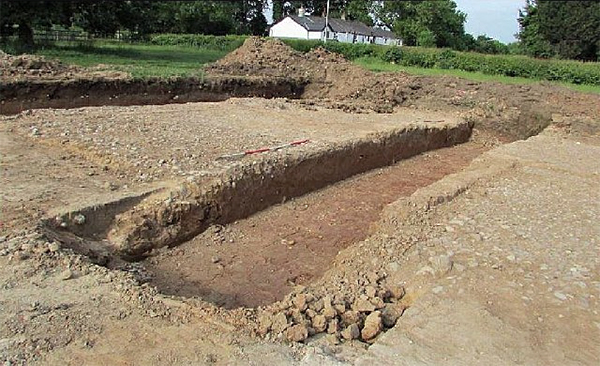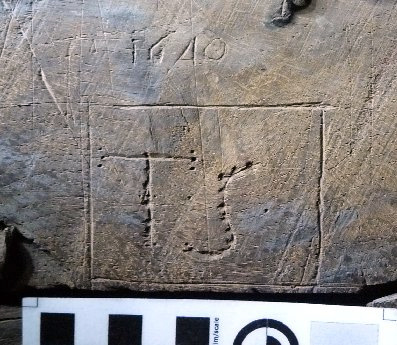
A huge section of the Roman road connecting Wigan with Walton-le-Dale was uncovered this summer at Farrington near Leyland. Although the excavations were carried out in May and June, it is only now that publicity restrictions have been lifted. The work was done by Salford Archaeology Unit as part of a series of excavations. This was in advance of a huge development planned for the area encompassing the Cuerden Green hamlet south of the M65 terminus. An evaluation trench had already identified a cobble surface triggering a full scale excavation of the site which lay on the east side of Stanifield Lane just south of Stoney Lane. An area 30m x 40m was machine stripped revealing a metalled surface over 10 metres wide stretching along the full length of the excavation.
There was clear evidence of cambering toward the edges and a 'V' shaped ditch running down the east side confirmed it to be the remains of a major Roman road. Its position also conforms with the alignment suggested by a section discovered in 1996 at Walton-le Dale i.e. projecting along Todd Lane, Stanifield Lane and eventually the A49 (Wigan Road) through Euxton. Any evidence of a ditch on the west side of the road had been destroyed by a modern field boundary ditch. However a section cut through the road showed it to be just over 11 metres wide but quite shallow in depth with no underlying features. This suggests that the surface had been cleared or levelled prior to the road being laid (this was similar to our findings at Brimelow Farm). It is significant to note that this is a totally different method of construction to that used on sections of the road south of Wigan (e.g. at Landgate Farm). There, the original surface had survived together with a clay base and large angular stone blocks, topped with smaller stones and a rammed gravel surface. At Leyland other features were also exposed just a few metres east of the Roman road including what appeared to be an Iron Age round house. Further north on the other side of Stoney Lane a Medieval field boundary system was discovered and, just south of Lostock Lane, the remains of a 17th century farmstead (details of the site at Stanifield can be seen on our blog site here.)
All this work had to be curtailed however when the main collaborator, IKEA, pulled out of the development. Lancs CC are determined to resume the development in the not too distant future and this hopefully will enable more discoveries to be made.
Historic Graffiti
Our work on the St Wilfred's project (reported in our April Newsletter No. 211) was resumed in December with recording and photographing the marks discovered on the spiral staircases of the church's stone turrets. The trickiest job however was with the north turret door where we discovered over 45 individual inscriptions carved on the back of it. These were mainly personal initials, seemingly all from a similar period, which, if the inscribed dates can be believed, come from the mid 17th century (by the way, a suspected scorch mark never materialised). All marks are recorded now and the report is well on its way. When complete, copies will be sent to the NW Regional Project to be included in their archive and also hopefully a version will be made available on line (you can follow our progress on our blog site here.)

Programme for 2019
This is always a work in progress at this stage but already booked is a talk on the Archaeology of the Lune Valley including recent work at the Roman fort at Lower Barrow Bridge. This will be given at our March meeting by Steve King who gave us a talk a couple of years ago on Historic Turkey. In April we have Dr Mike Nevell who will be telling us about the intensive underground canal system at Worsley (including news of more recently discovered tunnels). Ron Cowell from Liverpool Museum Services will be visiting us in May with an update on his exciting Mesolithic site at Lunt Meadows near Sefton.
Next Meeting
Wednesday 6th February. - in the Standish Suite at the Brocket Arms (7.30pm as usual). As always at this time of the year, we will be having our AGM, but this will be followed, you will be pleased to hear, by a presentation from our always entertaining chairman, Patrick. It has been quite unprecedented the number of projects we've been involved in this last year - 3 Roman road sites, a Roman fort as well as our Historic Graffiti survey. Patrick will be reviewing most of this field work by extending the talk he gave to both the CBA Conference at Ribchester and GM Federation meeting last November. Hope to see you then - BA.
|



